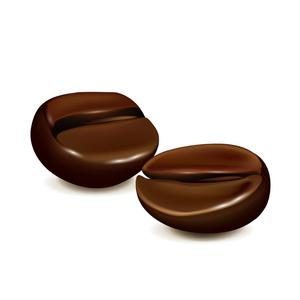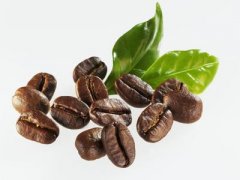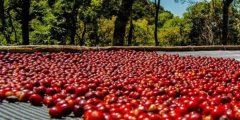A brief introduction to the planting market price of Panamanian Kasha boutique coffee beans as sour and sweet as juice

Slightly deeper baking, dry fragrance in the sweet vanilla and nectar sweet blend together, intoxicating, high+ baking degree, acidity decreased, mellow, but also significantly increased sweetness, fruit acid is also softer and vivid, in the aftertaste can still feel a strong sense of sweetness and fragrance of fruit here the coffee grows at an altitude of 1500 meters, the coffee garden is surrounded by a well-protected natural tropical ecological garden Nearby Baru Volcano National Park and La Amistad National Park are natural protected areas for animals and plants, which form the manor's unique microclimate and unique flavor thanks to Boquete's unique climate, distinct dry and wet seasons, ample sunshine and precipitation, as well as fertile soil formed by volcanic ash from the Balu volcano. Lelida Manor's coffee cultivation soon became its own climate in 1929. The coffee beans of the estate were exported to Germany for the first time, which won a good reputation for Panamanian coffee. In the following 3/4 centuries, as a family manor, Lelida coffee cultivation continued to develop, forming its international word-of-mouth story from the last century, from the digging of the Panama Canal. This maritime traffic route, on a par with the Suez Canal, and the dividing line between North and South America, should also be the first landmark that comes to mind when the world talks about Panama.
The construction of the Panama Canal lasted 30 years from 1883 to 1914. At first, the French led the project, and then the development rights fell to the Americans, during which as many as 50,000 craftsmen and technicians were employed, many of whom were engineers from northern Europe. Toleff Bache M?nniche is one of them.
The Norwegian engineer, who graduated from Dresden, Germany, was in charge of gate technology at the port of Cologne on the Panama Canal. Tropical rain forest climate in Panama, hot and humid and mosquito ravages make it difficult for many Nordic people to adapt, continue to suffer from disease, many people died as a result. In 1911, Toleff Bache, who had suffered from malaria for the fourth time, took a steamboat along the Pacific coast to the small town of Bopquete in Chiriqui province, where the dry climate and fresh air were suitable for recovery. Deeply in love with the land, he returned here with his wife Julia in 1924 and bought a piece of land at the foot of the Baru volcano, what is now Lelida Manor. They built their own house here, Nordic-style architecture, and have lived here ever since, and started the operation of the coffee farm.
The Panamanian flag was launched on November 3, 1904. The flag is rectangular and the ratio of length to width is 3:2. The flag consists of four rectangles of white, red and blue. White symbolizes peace; red and blue represent the former Panamanian Liberal Party and the Conservative Party respectively, and they are also symbols of the two parties' United struggle for the interests of the nation. The blue star on the white background at the top left represents loyalty and integrity, while the red star on the white background at the lower right represents the authority of the law. The design of the crosshairs divided into four pieces represents that Panama is located at the junction of South America, North America, Atlantic and Pacific Ocean. Red, blue and white are the colors of the American Stars and Stripes that support the independence of Panama. The national flag was designed by Manuel Amador Guerrero, the first president of Panama, and the current constitution of Panama entered into force on October 11, 1972, after four amendments in 1978 and 1983, 1994 and 2004. The Constitution stipulates that the three powers of the state are separated and that the President is the head of state and shall be elected by direct election for a term of five years without re-election, but may run for another term. On October 4, 1994, the Pakistani parliament stipulated the abolition of the army and the establishment of a police force. In October 2004, the Constitution made another important amendment, requiring the National Assembly to change its name to the "National Assembly"; the Constituent Assembly as the third way to amend the Constitution; and to abolish the post of Vice President. Members are free to nominate for the election, and each member retains only one alternate member. The current government of Panama was formed on July 1, 2009. the main members are: vice President Juan Carlos Varela, Minister of the Presidential Office Jimmy Papadimitriu, Foreign Minister Fernando Nunez Favre, Minister of the Interior Jorge Ricardo Favre, Minister of Public Security Jose Raul Murino Minister of economy and Finance Frank George de Lima, Minister of Commerce and Industry Ricardo Quijano, Minister of Agriculture and Animal Husbandry Development Oscar Armando Osorio Kassar, Minister of Health Javier Diaz, Minister of Housing Yasmina Pimentel (female), Minister of Labour Armah Lorena Cortez (female), Minister of Social Development Guillermo Ferrufino Minister of Education Lucy Molina (female), Minister of Public works Jaime Ford, Minister of small and medium Enterprises Heathrow Brillo (female), Minister of Canal Robert Roy, Minister of Tourism Salomon Sama.
Panamanian coffee is famous for the rosy summer of the Emerald Manor, which is also famous in the Boquete region of its Chiriqui province. Boquete is a town of Chiriqui in the province of Ricki, located near the border between Panama and Costa Rica, close to the famous Baru Baru volcano, with rich and fertile soil, climate and soil that are suitable for producing quality coffee.
There are many excellent manors in the Pokuit area, except the famous Emerald Manor, Alida Manor, Aqaba Manor and so on, all of which produce high-quality boutique coffee. This is not only due to the superior ecological conditions of the Pokuit region of Panama and the fertile volcanic ash soil of the Baru volcanic land. Another important factor is that the microclimate in the Poquet Heights of Panama is a unique and important resource for boutique coffee in the Pokuit region. This is the Panamanian environment from east to west that allows cold air to converge above 6500 feet through the Central Mountains, thus creating a variety of microclimates in the Pokuit region, making its temperature and rainfall very suitable for plant growth. so the coffee trees grown here grow very well.
In Poquet's unique planting environment, there is naturally not only the rose summer of emerald, the king of coffee, regardless of flavor, quality and value, but I think it is quite extravagant to drink rose summer every day, and even if there is no economic pressure, it is not like eating shark's fin and bear's paw every day. The same is true of coffee. Only by dabbling in a wide range of subjects can you enjoy the pleasure of tasting coffee more.
Then in the land of Pokuit, there is a bean with a high performance-to-price ratio. And it has a very beautiful name-Flower Butterfly. She has 40% high-quality Rosa pedigree, which is composed of Rosa, Kaddura and Kaduai. It is planted in the Baru volcano region of Pokut and grows in the volcanic area at an altitude of 1600 meters. The treatment plant uses fine washing treatment. Panama's special local microclimate leads to abundant rainfall in this area, and a large temperature difference between day and night, coupled with the unique volcanic rock and soil of the volcanic area, as well as meticulous harvesting and fine treatment. It makes this coffee perform well in terms of richness, acidity and floral aroma. Coffee was first brought to Panama by European settlers in the 19th century. In the past, Panamanian coffee did not have a good reputation, and its output was only 1 / 10 of that of its neighbor Costa Rica, but now the coffee industry's focus on boutique coffee has made Panama more and more interested in growing coffee.
Panama's geographical advantage is that it has many distinctive microclimate areas suitable for coffee cultivation, and Panama also has many persistent and professional coffee growers. This means there will be a lot of very good coffee in Panama, but these coffees are often associated with high prices.
The high price of coffee in Panama is mainly caused by the following factors:
Land price: for the people of North America, they very much want to buy a stable and beautiful land at a low price. Panama is such a place.
More Panamanian farmers export coffee in the name of manors to emphasize their manors
Panamanian labor law has higher requirements for labor employment, so the coffee industry needs to pay higher wages.
Grower: Familia Chiari
Area: Pokuit Town, Panama Macedonian Province
Variety: completely washed
Height: 1500 m
Harvest time: October to March of next year
Soil: pozzolanic soil
Cup test keywords: caramel sweet, sweet, pure, balanced, medium mellow, it is worth mentioning that the manor also operates its own characteristic hotel, as well as its own characteristic restaurant and coffee shop, where you can enjoy the leisure experience of food, accommodation and travel. In addition, there are special coffee tours and bird watching tours, going deep into the rainforest and entering the habitat of the red cuckoo, a national protected animal in Panama.
There is another dream travel destination-Poquet, which was once selected by Fortune magazine as one of the five most beautiful towns in the world for retirement. Before I grow old, I must see you. Going to Lelida Manor has always preferred the strong taste of African beans, and the Central American beans seem to be synonymous with moderates to me, whether it's Costa Rica or Guatemala. Caribbean island coffee is closer to the pronoun of "fruit juice". And this Panama did give me a pleasant surprise, refreshing fruit acid is obviously more vivid than other countries in China and the United States and closer to the ripe sweet and sour aroma of the fruit, while the entrance, in addition to a balanced and clear, rich sweetness and slightly syrup sticky taste to enhance its smoothness and vitality-except for the floral and citrus flavor, the overall taste is not inferior to the fresh emerald green appearance of Rose Summer. The beans are full and shiny, and they are hard beans with high density at a glance. Baked to an obvious degree of high fruit aroma shows, the entrance is also juice-like sweet and sour, bright and refreshing.
Important Notice :
前街咖啡 FrontStreet Coffee has moved to new addredd:
FrontStreet Coffee Address: 315,Donghua East Road,GuangZhou
Tel:020 38364473
- Prev

A brief introduction to the origin, development, history and culture of Panamanian Kasha boutique coffee beans with unique orange flavor and honey flavor
This is good. Coffee bugs benefit from Panama's geographical conditions from east to west, allowing cold air to flow through the Central Mountains and converge at more than 6500 feet, thus forming a variety of unique microclimates in places such as Boquete, Volcn, Candela and Santa Clara, coupled with nutrient-rich and balanced volcanic ash soil.
- Next

A brief introduction to the planting situation of Panama Kasha boutique coffee beans, geographical location, climate and altitude
Panamanian coffee is classified and numbered into small batches, which are designed to have a small capacity for optimal management, and classification numbers allow buyers to understand and track the entire process. Because of its small quantity, Panamanian coffee products are based on special coffee. The country provides its high-quality products to specialized stores around the world, such as Denmark, Britain, Greece, Norway, Sweden and South Africa.
Related
- Detailed explanation of Jadeite planting Land in Panamanian Jadeite Manor introduction to the grading system of Jadeite competitive bidding, Red bid, Green bid and Rose Summer
- Story of Coffee planting in Brenka region of Costa Rica Stonehenge Manor anaerobic heavy honey treatment of flavor mouth
- What's on the barrel of Blue Mountain Coffee beans?
- Can American coffee also pull flowers? How to use hot American style to pull out a good-looking pattern?
- Can you make a cold extract with coffee beans? What is the right proportion for cold-extracted coffee formula?
- Indonesian PWN Gold Mandrine Coffee Origin Features Flavor How to Chong? Mandolin coffee is American.
- A brief introduction to the flavor characteristics of Brazilian yellow bourbon coffee beans
- What is the effect of different water quality on the flavor of cold-extracted coffee? What kind of water is best for brewing coffee?
- Why do you think of Rose Summer whenever you mention Panamanian coffee?
- Introduction to the characteristics of authentic blue mountain coffee bean producing areas? What is the CIB Coffee Authority in Jamaica?

